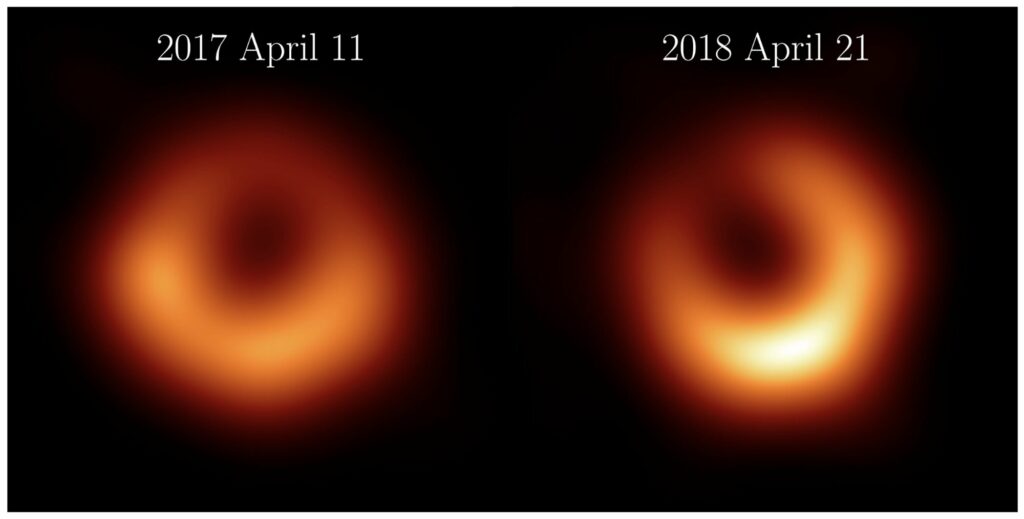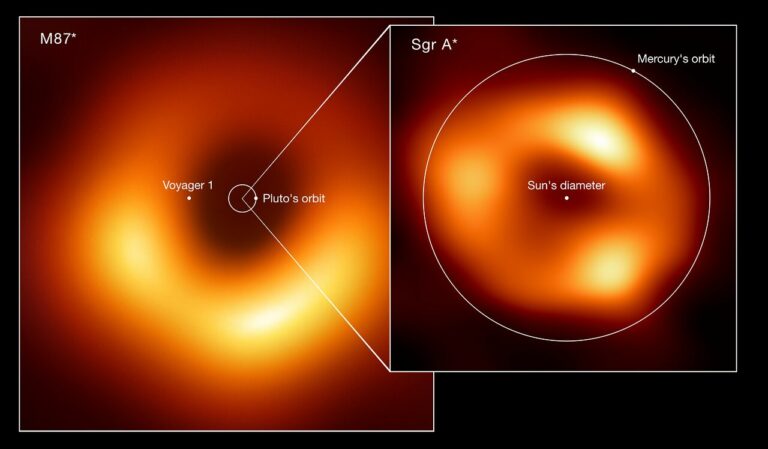Consistent Appearance in M87* Despite New Data
Nearly five years ago, a globe-spanning team of astronomers gave the world its first-ever glimpse of a black hole. Now the team has validated both their original findings and our understanding of black holes with a new image of the supermassive black hole M87*. This supermassive black hole, 6.5 billion times the mass of our sun, resides at the center of the Messier 87 (M87) galaxy in the Virgo galaxy cluster, located 55 million light-years from Earth.
The new image, like the old one, was captured by the Event Horizon Telescope (EHT), an array of radio telescopes stretching across the planet. These new data, however, were gathered a year later, in 2018, and benefited from enhancements in the telescope array, notably with the inclusion of a telescope in Greenland.
EHT’s original image of M87* was important not just because it represented the first time humans had imaged a black hole, but also because the object looked the way it was supposed to look. Notably, the image showed what is known as a black-hole shadow—a dark region at the center of a glowing disk of hot matter circling the black hole. A black-hole shadow isn’t a shadow in the same sense as the one you cast when you walk outside on a sunny day. Instead, the dark region is created by the black hole’s immense gravitational field, which is so strong that light cannot escape it. Since no light leaves a black hole, it appears dark.
Additionally, that strong gravity bends light that passes near the black hole without falling into it, effectively acting like a lens. This is known as gravitational lensing, and it creates a ring of light that can be seen regardless of the angle from which the black hole is viewed. These effects were both predicted from Albert Einstein’s theory of general relativity. Because M87*’s image shows these effects, it is strong evidence that general relativity and our understanding of the physics of black holes is correct.
This new M87* image was produced with key contributions from an imaging team at Caltech, including Professor Katherine (Katie) L. Bouman, assistant professor of computing and mathematical sciences, electrical engineering, and astronomy; former Caltech Ph.D. student Nitika Yadlapalli Yurk, Ph.D.; and current Caltech postdoctoral research associate in computing and mathematical sciences Aviad Levis.

Bouman is a coordinator of the EHT Imaging Working Group and was a postdoctoral fellow at the Harvard Smithsonian Center for Astrophysics and co-lead of the EHT imaging team when the original image was published in 2019. In that role, she helped develop the algorithms that assembled the trove of data collected by the EHT’s multiple radio telescopes into a single, cohesive image. Since joining the Caltech faculty, Bouman, who is also a Rosenberg Scholar and Heritage Medical Research Institute Investigator, has continued her work with EHT. She also co-led the imaging of the Milky Way’s supermassive black hole published in 2022.
Yurk joined the EHT Collaboration in 2020 and played an active role in the imaging team for the latest M87* image. Her main contributions included developing synthetic datasets to be used in the training and validation of the imaging algorithms. Yurk also wrote software that was used in the exploration of image candidates. She was recently recognized by the EHT for her efforts with a Ph.D. Thesis Award for the advances she brought to the imaging and validation of the most recent M87* image. She is currently a NASA Postdoctoral Program fellow at JPL, which Caltech manages for NASA.
Imaging an object like M87* with the EHT is very different than imaging a planet like Saturn with a conventional telescope. Instead of seeing light, the EHT observes the radio waves emitted by objects and must computationally combine the information to form a picture.
“The raw data that comes out of these telescopes are basically just voltage values,” Yurk says. “I like to describe radio telescopes as the world’s most sensitive volt meters, and they collect voltages really accurately from different parts of the sky.”
Turning those voltage values into an image is tricky, Bouman says, because the information the researchers are working with is incomplete, and there is nothing to compare the image against since no one has seen M87* with their own eyes.
“We don’t want to plug in our expectations of what the black hole should look like when we’re computationally forming the image,” Bouman says. “Otherwise, it might lead us to an image that we expect rather than one that captures reality.”
To avoid that problem, the researchers test their image processing algorithms with what is known as synthetic data, a suite of simulated images with simple geometric shapes. Those data are run through the algorithms to produce an image. If the output image is true to the input image, they know the algorithm is working correctly and would be able to accurately see surprising structures around the black hole.
Bouman says that process, which was co-led by Yurk, involved exploring hundreds of thousands of parameters to gauge the effectiveness of the algorithms in reconstructing different image structures. The team found that with the addition of the Greenland telescope to the EHT, the methods more robustly recovered features in the images.
Bouman adds that the team’s ability to produce another image of M87* with new data that agrees so closely with the previous image is exciting.
“I think that people are going to ask, ‘Why is this important? You already showed a picture of M87*.’ Other groups have reproduced the M87* picture with data that were taken in 2017. But it’s a totally different thing to have a new dataset taken a different year and to come to the same conclusions. Reproducibility with independent data is a big deal, too.”
This article is republished from PhysORG under a Creative Commons license. Read the original article.
Do not forget to share your opinion with us to provide you with the best posts !




0 Comments